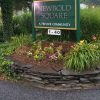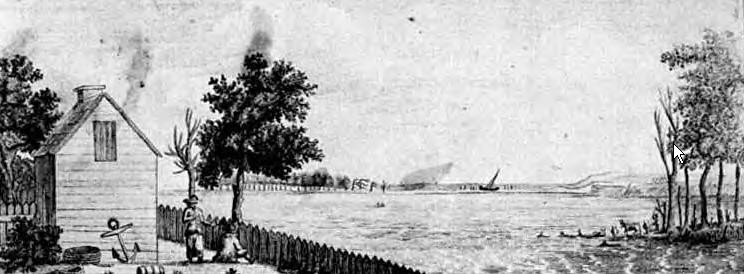A Look into the History of the Newbold Name
provided by Frank Bingman
The *Indian River flows into Indian River Bay south of Rehoboth. The Newbold plantation beach is on a fresh water pond protected from the Atlantic by a narrow isthmus. The contemporary account of this view describes the Indian corn, cider, iron ore, yellow ocher, and seaweed useful in glass manufacture available in the area and remarks:
“Many other valuable articles of trade and manufacture might be obtained here with proper attention and encouragement. But without the industry of man, the best shores of nature must lie useless and unexplored.” Frontispiece for The Columbian Magazine, June 1788. LC-U5Z62-3 1796
*Indian River , 10 mi/16 km long, Sussex co., SE Del., tidal estuary formed by small streams just W of Millsboro (dam here); flows E, widens into Indian R. Bay before entering Atlantic Ocean through narrow passage in Del. Seashore State Park 5 mi/8 km N of Bethany Beach.
[Note: The following information was provided to this webmaster by Mr. Henry Cree Newbold of Columbia, Maryland on February 26, 2005. He has never visited this historic area and hopes to do so someday.]
A Family History Library record shows the date of marriage of James NEWBOLD to Hannah Jacobs as being on September 8, 1777. He was the administrator to the estate of one Sarah Jacobs in 1791 in Sussex County.
According to Vernon L. Skinner’s “Proceedings of the Orphan’s Court of Sussex County” published in 2000, page 204, James’ wife Hannah was the daughter of one Albertus Jacobs, deceased, who owned 1000 acres of land in Lewes and Rehobeth Hundred. Albertus Jacobs had a will dated August of 1776, which was probated in September of 1776. According to the record, which was a petition by Hannah Jacobs NEWBOLD, both of the sons of Albertus Jacobs, who would have inherited the land, had died. The record stated that the “land descended to the sisters”, who were Hannah, Hester, and Comfort. If James and Hannah inherited part of this estate by virtue of her rights, it might explain why they lived in Lewes and Rehobeth Hundred, and how James NEWBOLD came to own some very nice property there.
James NEWBOLD’s homestead was immortalized in a magazine in 1788! The Frontspiece for “The Columbian Magazine” of June 1788 is entitled: “A View of the Sea & Beach”, from Mr. James Newbold’s Plantation, near Indian River. The Indian River flows into Indian River Bay south of Rehoboth. The Newbold plantation beach is on a fresh water pond protected from the Atlantic by a narrow isthmus. The contemporary account of this view describes the Indian corn, cider, iron ore, yellow ocher, and seaweed useful in glass manufacture available in the area and remarks:
“Many other valuable articles of trade and manufacture might be obtained here with proper attention and encouragement. But without the industry of man, the best shores of nature must lie useless and unexplored.”
This property was also mentioned on page 1215 of the book “History of Delaware”:
“Rehoboth Bay is a large, beautiful sheet of water, full of fish and visited by vast flocks of wild fowl. On some of its shores oysters were found as early as 1662. NEWBOLD’s Lake and Gordon’s Pond are fresh water bodies, whose size has been decreasing on account of the drifting sands, which have been slowly filling them up.”
This location also appears in an account of the War of 1812, “Pictorial Field Book of the War of 1812” By Benson J. Lossing, published in 1869. In Chapter 30, entitled “Predatory Warfare of the British on the Coast” is this entry:
“On the afternoon of the 7th 1813 the British attempted to land for the purpose of seizing live-stock in the neighborhood, but they were met at the verge of the water by the spirited militia, and driven back to their ships. For a month the squadron lingered, and then, dropping down to Newbold’s Ponds, seven miles below Lewistown, boats filled with armed men were sent on shore to obtain a supply of water. Colonel Davis immediately detached Major George H. Hunter with a few men, who drove them back to the ships. Failing to obtain any supplies on the shores of the Delaware, the little blockading squadron sailed for Bermuda, where Admiral Warren was fitting out re-enforcements for his fleet in the American waters.”
On an 1868 dated map of Rehoboth Delaware, long after James NEWBOLD had died, this body of water was still labeled as “NEWBOLD’s Freshwater Lake” [from p. 13 of “Visiting Sussex”, by Sussex County Bicentennial Committee, 1976]. At some point after this time, the lake was renamed “Silver Lake”, which is now surrounded by present-day urban Rehoboth Delaware. [A 1938 book, “Delaware: a guide to the first State”, Viking Press, on page 409 also makes reference to this name change: “…at the southern town limits of Rehoboth, the highway crosses Silver Lake (“Newbold’s Freshwater Lake” on early maps)….”]
James NEWBOLD is found on the 1800 Federal Census in Sussex County Delaware. His household listed a male in the over age 45 bracket [James]; a female in the over age 45 bracket [Hannah]; and a female in the between age 10 and 16 age bracket. Is this an indication of a daughter?
James NEWBOLD is found again on the 1810 Federal Census in Sussex County. Listed in the household is a male over age 45 [James]; a female over age 45 [wife Hannah]; and a female between ages 16 and 26. Is this another indication that they did in fact have a daughter?
A possible clue: according to a genealogy posted to the LOWER-DELMARVA-ROOTS-D Digest V02 #68 of 21 Mar 2002: “HANNAH NEWBOLD HOLLAND was born 22 Mar 1833 in Broadkill Hd., Sx Co., DE, and died 24 Dec 1859 in Sussex Co., DE. She married JOHN CRAIG LANK 5 Feb 1857, son of MITCHELL LANK and HANNAH JEFFERIS. He was born 23 Dec 1818 in Lewes & Rehoboth Hundred, Sussex Co., DE, and died 27 Mar 1878 in Lewes & Rehoboth Hundred, Sussex Co., DE.”
The parents of Hannah NEWBOLD Holland were listed as Ebenezer Holland and Elizabeth Dodd. What is interesting is that both of these surnames are prominent in the estate execution of James NEWBOLD in 1831 — a William Dodd was named by James NEWBOLD to witness his Will, and a John Holland witnessed the signature by William Dodd on James NEWBOLD’s verbal Will. Elizabeth Dodd’s father was named William Dodd. And Hannah was James NEWBOLD’s wife’s name. So why would Ebenezer Holland and wife Elizabeth Dodd name a daughter born in 1833, two years after James NEWBOLD died, “Hannah NEWBOLD” Holland? And finally, listed in the Dodd Family Bible on page of Deaths is:
James Newbold died August 25, 1831.
Hannah Newbold died August 14, 1825.
UPDATE: Mr. Cree Newbold emailed the following information to me on December 24, 2007.
“Recently I uncovered an absolutely fantastic document which finally showed me exactly where my ancestor lived in proximity to Silver Lake, and thus why it was known as Newbold’s Lake or Pond.
When James Newbold died in 1831, he had no direct descendants. The Orphan’s Court of Sussex County was approached by descendants of two of his deceased half-siblings, a half brother named John Rhodes, and a half sister named Mary Fassit Thompson [all had the same mother, but each had a different father. In fact, James Newbold’s mother is known to have married, and had children by, no less than 6 (!!!) men between the early 1740s and early 1760s! James’ father John Newbold was husband #4. Husband #1 was named John Rhodes, and Husband # 2 was William Fassit, whose daughter Mary Fassit married William Thompson.]
I recently received the Orphan’s Court documentation related to the claims of descendants of these two half siblings for their share of James Newbold’s land. This documentation first of all made it very clear that James Newbold must have never had any children who survived childhood. But the exciting thing was that in the process of the Court figuring out who should get what, there was a detailed survey of his lands made, and the results of this survey was in the documentation, including the surveyors drawing of the land showing the size, shape, and neighbors. James Newbold’s larger tract of land, over 162 acres, occupied all of the area north of what was labeled “Newbold’s Pond”, now Silver Lake. The eastern side of the land that abuts the “sea beach” is as Silver Lake is adjacent now.
For me, this finally proves why the lake was known as “Newbolds Lake”, as his property bordered it completely on the north and ran to the west for quite of ways. Of interest is that it would appear that the Lake or Pond does NOT seem to be part of the property, as the survey describes James Newbold’s property in terms of the north shoreline, and not encompassing the lake as a whole. I will deduce that it was not owned by anyone else, either, since if it were, then the logical thing would be that it would be otherwise named. Perhaps this freshwater body of water was always considered public property, as like any river or stream?”



